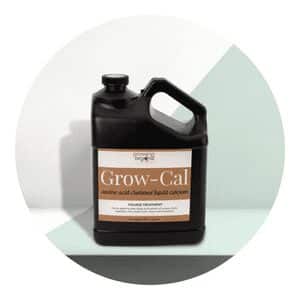Cover Crops and Green Manures
Cover crops and green manures are two invaluable tools for improving soil health and fertility.
They provide a wide range of benefits to agricultural operations, including preventing soil erosion, suppressing weeds, increasing water infiltration, and improving nutrient levels in the soil.
Cover crops are planted between main crop cycles while green manures are planted prior to a main crop being sown in order to be tilled into the soil as organic matter.

Cover Crops and Green Manures Menu
Cover Crops and Green Manures
In the agricultural world, cover crops and green manures have become a popular way for farmers to keep their soil healthy and productive.
Cover Crops and Green Manures are an effective form of crop rotation that replenishes the soil with nutrients, improves its structure, reduces erosion, increases water infiltration, suppresses weeds and pests, and helps control certain diseases.
Cover crops are grown between cash crop season to protect the soil from erosion and reduce weed growth.
It can also act as a natural fertilizer by returning nitrogen into the soil through a process called nitrogen fixation.
Meanwhile, green manures are planted in order to return organic matter into depleted soils.
They may be either living or dead plants which release nutrients when dug into the field or left on top of it as mulch.
Definition of cover crops and green manures
Cover crops and green manures are a sustainable farming practice that has been used for centuries to improve soil fertility, reduce erosion and control weeds.
Cover crops are planted between cash crop cycles or during fallow periods, while green manures are planted as part of an active cropping rotation.
Both provide numerous benefits to the environment and agricultural production.
Cover crops fix nitrogen, suppress weeds, conserve moisture in the soil and protect the structure of the soil from erosion.
They can be harvested as a source of organic matter or left to decompose in situ.
Green manures have similar effects but they may also contain beneficial bacteria or fungi which further improve soil health by increasing nutrient cycling and helping suppress pests and diseases.
Benefits of using
Cover crops and green manures are a great way to naturally fertilize the soil in your garden.
By planting cover crops or green manures, you can improve the quality of your soil while providing protection from erosion and weeds.
Not only do they help reduce the amount of time spent weeding and mulching, but they also provide many other benefits.
One of the main benefits is that cover crops and green manures act as natural fertilizer, as their roots increase nutrient availability in the soil by releasing nitrogen-rich compounds into it.
They also retain water for longer periods than bare ground does, helping to reduce water loss during dry spells or droughts.
Additionally, these plants create a dense layer which prevents weed growth, reducing the need for chemical herbicides that can harm beneficial insects such as bees and butterflies.
Types of Cover Crops and Green Manures
Cover crops and green manures are an important tool for farmers and gardeners alike.
Cover crops, also known as green manure, are plants grown on a field to improve soil fertility, manage weeds, and provide beneficial habitat for wildlife.
Green manures can be used in both organic and traditional farming systems with great success.
There are many types of cover crops that can be used depending on the area’s climate and terrain.
Some of the most popular cover crop varieties include alfalfa, annual ryegrass, clover, buckwheat, peas, vetch and rye grasses.
Each variety has its own set of benefits; some fix nitrogen in the soil while others increase microbial activity or reduce erosion.
Cover crops, our protectors of the soil, They keep the cover and nutrients toil. The green manures complete the system's deed, Limiting erosion and causing a need. For more plants like clovers take their part, In fixing nitrogen from night till start. The digging in does not have to be grand, Leaving food for worms and giving land a hand.
Chappy The Gardener
Legumes (e.g. clovers, beans, lentils)
Legumes are an important part of the cover crop and green manure family.
This group of plants includes clovers, beans, lentils and other species which provide a range of benefits to the soil in which they grow.
Legumes contain special root nodules that form symbiotic relationships with nitrogen-fixing bacteria.
This relationship helps to build up available nitrogen levels in the soil, improving fertility for other plants.
Growing legumes can also help reduce erosion on agricultural land as these plants spread quickly over available space due to their high numbers of seeds and their winding growth pattern.
In addition, legumes have deep root systems which further aid in preventing soil loss from wind or water erosion.
Legume cover crops also act as living mulch, helping to reduce weed growth by blocking light from reaching weed seeds below the surface.
Grains (e.g. oats, barley, rye)
Grains are a wide-ranging, highly nutritious food source that have been consumed for centuries.
From oats and barley to rye and wheat, grains are the cornerstone of many diets around the world.
These whole grains offer an array of health benefits and can often be used as cover crops or green manures in agricultural fields.
Cover crops and green manures provide numerous benefits to crop production such as increased fertility, improved soil structure, and reduced erosion.
Grains make excellent cover crops because their dense root systems help build soil structure while increasing organic matter in the soil.
Additionally, they can be grown relatively quickly with little effort making them an ideal choice for farmers looking to maximize their harvest yields without sacrificing quality.
Grains also make great green manures due to their high nutrient content which helps to restore nitrogen levels in depleted soils over time.
Brassicas (e.g. mustard, radish)
Brassicas are an essential part of cover crop and green manure practices.
These crops, which include mustard, radish, and other varieties, are versatile and have multiple benefits for the soil.
They can be used as a living mulch or planted in succession to provide a continuous supply of nutrients to the soil.
Brassicas help reduce erosion by stabilizing the surface of the land.
In addition, their deep roots enable them to reach into deeper soil layers for nutrients that other plants may not be able to access.
This helps create healthier soils with better structure, water retention capability and aeration levels for better crop yields.
The presence of Brassicas also encourages beneficial microbial activity in the soil which aids in nutrient cycling and disease suppression.
Other types of cover crops and green manures
Cover crops and green manures are an important agricultural practice for preserving soil fertility, reducing erosion, and providing food for wildlife.
Beyond this, there are other types of cover crops and green manures available for farmers to maximize their yields.
For example, legume cover crops such as clover, alfalfa, Austrian winter peas and vetches provide beneficial nitrogen to the soil while suppressing weeds.
Legumes also attract beneficial insects that help reduce pest pressure on crop plants.
Other non-legume cover crops such as cereal rye or oats can be used to reduce weed pressure by shading out light needed for germination.
They also scavenge up residual nitrogen in the soil profile which helps reduce leaching losses over time.
How to Use
Cover cropping and green manuring are two powerful tools for improving soil health, regulating pests, and managing weeds.
For gardeners, farmers, and homesteaders alike, understanding how to use these techniques will help them achieve a better yield from their land.
We’ll also discuss how to choose the right cover crop or manure for your particular situation and how to best implement these practices into your current garden or farming plan.
Finally, we’ll offer some tips on how to maintain healthy soils with cover crops and green manures.
When to plant
Cover crops and green manures have become an essential tool for farmers to maintain healthy soil and reduce environmental impact of agricultural production.
But when is the best time to introduce these methods into a farming operation?
Understanding when to plant cover crops and green manures can help farmers maximize the benefits of these practices while minimizing any potential problems that may arise.
The optimal planting time depends on several factors, including the size of the farm, local climate, type of crop being grown, and existing soil fertility levels.
Generally speaking though, it’s best to sow cover crop or green manure seeds two weeks prior to planting your main crop.
This will allow enough time for adequate growth before your main crop germinates and prevents competition between them for water or nutrients in the soil.
How to prepare the soil for planting
Cover crops and green manures are some of the most important tools for preparing soil before planting.
Planting in soil that has not been properly prepared can lead to unhealthy plants, reduced yields, and increased pest problems.
To get the most out of cover crops and green manures, it is important to understand how to best use them for soil preparation.
The first step in preparing the soil with cover crops or green manures is choosing which type you would like to use.
Cover crops typically include legumes such as clover or vetch, while green manures often include grains like wheat or oats.
The next step is determining when they should be planted; this will depend upon whether you want them to act as a fertilizer during fallow periods, or if you plan on harvesting them once they have grown.
How to incorporate cover crops and green manures into the soil
Cover crops and green manures are two beneficial practices to help boost soil fertility.
Incorporating them into soil can help improve the quality of the land and provide essential nutrients for future crops.
Knowing how to correctly implement these practices is key to cultivating healthy, productive soil.
These techniques involve planting a mixture of legumes such as clover or alfalfa, which fix nitrogen in the soil, and grasses like ryegrass or wheat which add organic matter to keep soil moist.
Cover crops should be planted during the growing season before harvesting a main crop.
Then after harvest, cover crops should be tilled back into the ground so that their roots can break down and release nitrogen-rich materials back into the soil.
Common Challenges and Solutions
Cover crops and green manures are two invaluable tools for sustainable agriculture, offering numerous benefits in terms of preserving soil health and fertility.
While these practices can be incredibly valuable, they also bring with them a range of common challenges.
In this fourth installment of our series on cover crops and green manures, we’ll look at some of the most frequent issues farmers face with these systems and how to address them.
Time is often one of the major concerns when it comes to cover crops or green manures; many farmers find their already busy schedules overwhelmed by the extra management required for installation, termination, and maintenance.
Managing cover crop growth and timing
Cover crops and green manures offer a range of benefits for soil health and provide an opportunity for farmers to increase the sustainability of their operations.
These techniques involve the use of cover crops, which are planted in place of the usual crop cycle, that protect and improve the quality of soil.
However, effective use requires careful management and timing to ensure optimal growth.
Farmers must decide when to plant cover crops in order to maximize their benefit.
Planting before harvest can help reduce weed populations by providing competition, while planting after harvest provides immediate protection from erosion or leaching.
Additionally, harvesting at the right time is essential; too early may result in inadequate nutrient recycling while too late can reduce yields or lead to difficulty with weed control.
Cover Crops and Green Manures offer great potential for improving soil health but require careful management in order to reap these rewards.
Dealing with pests and diseases
Cover crops and green manures are an important part of any sustainable agricultural system.
They offer numerous benefits, from increasing soil fertility to reducing erosion and providing habitats for beneficial insects.
However, there are challenges associated with this type of farming as well; pests and diseases can be a major issue.
In order to effectively deal with these issues, it is important to understand the causes of pest and disease infestations, as well as strategies for minimizing their impact on cover crops and green manures.
Frequently Asked Questions
Cover Crops and Green Manures are two important farming practices that can help promote healthy soil for growing crops.
There are a number of questions about these practices, so we have compiled the most common ones here to provide answers for anyone interested in learning more.
The first question is often about why cover crops or green manures are necessary.
Cover crops and green manures add organic matter to the soil, improving its structure and fertility while reducing erosion and controlling weeds.
They also increase microbial activity in the soil, which helps improve water retention as well as overall plant health.
Additionally, they can help reduce the need for chemical fertilizers by providing natural sources of nutrients like nitrogen, phosphorus, and potassium.
Another frequent inquiry is how to choose the right cover crop or green manure for your needs.
How to select the right cover crops and green manures
The cover crops and green manures you choose for your garden can make a huge difference in the quality of your soil and the success of your garden.
Making sure that you select the right ones for your particular needs is essential to getting the most out of them.
Here are some tips on how to choose the best cover crops and green manures for your garden.
First, consider what types of plants you have in your garden.
Different cover crops and green manures will provide different benefits depending on the type of soil they will be planted into and what type of other plants are already growing in it.
If you want to create nitrogen-rich soil, then legumes such as clover or vetch would be a good choice.
If you’re looking to improve soil structure, then oat grass or rye grass might be better suited.
How to store cover crops and green manures seeds
Are you looking for a sustainable way to fertilize your soil?
Cover crops and green manures are an excellent way to return needed nutrients back into the soil.
Not only can they provide beneficial nutrients, but they can be used as a natural weed inhibitor as well.
If you’re interested in using cover crops or green manures, the first step is understanding how to store their seeds properly.
Proper storage of cover crop and green manure seeds is essential to ensure that they will effectively germinate when planted.
Proper storage includes keeping them away from light, moisture, high temperatures, and rodents.
For best results, consider storing them in an airtight container made out of heavy plastic or metal with plenty of room for oxygen circulation inside the container.
How to use cover crops and green manures safely
Cover crops and green manures are a great way to add vital nutrients back into the soil, reduce erosion, and increase the organic matter.
Cover crops are grown specifically to protect and improve your soil while green manures are used to fertilize your fields with fresh organic matter.
First, it is imperative that you select cover crop species that will fit the needs of your particular area’s climate and environment as well as work with your existing crop rotation plan.
Once planted, be sure to keep an eye on the cover crops so they do not become overgrown or take over other areas in the garden or field.
In conclusion, cover crops and green manures offer a wide range of benefits to soil health, providing a sustainable way to fertilize and improve the fertility of the soil.
Cover crops also reduce erosion from wind and water, help naturally control weeds, prevent pests and diseases, as well as cycle essential nutrients into the soil.
When used in conjunction with other methods such as composting or nutrient cycling, cover crops can provide an effective and affordable solution to replenishing soil health.
Click To Grow

Chapter 1
Basics of Organic Gardening

Chapter 2
Choosing the Right Location and Preparation of the Soil

Chapter 3
Plant Selection and Planting
Helps Us Grow – Share If You Like


















